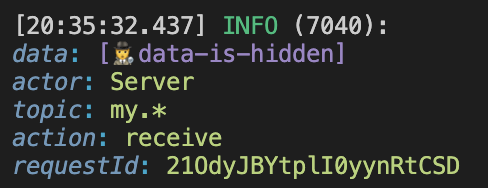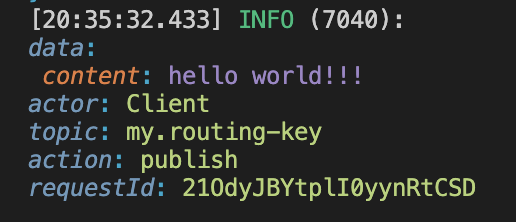Server Client Communication
This guide will provide a detailed example of how the communication between server and client is actually occurring.
The example we create will be a modified version of getting started; we will go through all the options the r4bbit API provides and explain all the details.
Create a server
While creating a server, we support all the possible options node-amqp-connection-manager gives; those options have good defaults; therefore, change them only if you know what you're doing.
const server = await getServer(
["amqp://guest:guest@localhost:5672/", "amqp://fallback@localhost:5672/"],
{
connectOptions: {
// optional (both connectOptions and all its options)
reconnectTimeInSeconds: 10,
heartbeatIntervalInSeconds: 10,
// ...
},
createChannelOptions: {
// optional (both createChannelOptions and all its options)
name: "my-channel-name",
// ...
},
}
);
Log presented after the connection is established.

Register a route
For a server to listen for the messages, we need to send them to a specific topic and exchange. r4bbit uses only topic exchange, which can actually listen a regular expression.
Handler function can be either AckHandler or just Handler; with AckHandler, you have the opportunity to acknowledge messages when you finish your operations. By default, AckHandler is used. To use just the Handler function, specify it in the options of registerRoute.
const handlerFunc: ServerTypes.AckHandler =
(
{ ack, nack } // In the handler function we provide an ack method you can use to acknowledge the message.
) =>
(msg: string | object) => {
if (!msg) return;
if (!ack) return;
try {
// process the message from the client
ack();
} catch (error) {
console.log("error", error);
}
};
server.registerRoute checks for the given queue name, and if it does not exist in the exchange, it creates it.
r4bbit has its own default logger (more about this topic in advanced guides/logger docs), but you can replace it with a custom one (such as winston etc.) if you want to.
To anonimize the logged data, set isDataHidden option to true (check out the example below).

// create a server with one route
await server.registerRoute(
{
queueName: 'my-queue',
exchangeName: 'my-exchange',
routingKey: 'my.*',
},
handlerFunc,
{
consumeOptions: { // optional
noAck: false, // default is true
},
loggerOptions: { // optional
isDataHidden: true, // default is false
},
responseContains: {
content: true, // default is true
headers: true, // default is false
},
}
);
);
Create a client and send the message
While creating a client, we support all the possible options node-amqp-connection-manager gives; those options have good defaults; therefore, change them only if you know what you're doing.
const client = await getClient(
["amqp://guest:guest@localhost:5672/", "amqp://fallback@localhost:5672/"],
{
connectOptions: {
// optional (both connectOptions and all its options)
reconnectTimeInSeconds: 10,
heartbeatIntervalInSeconds: 10,
// ...
},
createChannelOptions: {
// optional (both createChannelOptions and all its options)
name: "my-channel-name",
// ...
},
}
);
An example of a client sending the message:
await client.publishMessage(
{ content: "hello world!!!" },
{
exchangeName: "my-exchange",
routingKey: "my.routing-key",
loggerOptions: {
isDataHidden: false, // default is true,
},
sendType: "json", // default is 'json'
}
);
When a client sends the message, we print the log below.

Close the connection
You don't need to close the connection of your r4bbit client and server. Because in a normal app, a server should listen until the end of the application's lifetime.
But there are certain cases where you want to close the connection; we also provide this option.
To close a connection with the rabbitMQ broker, you can use close method - it's available for both server and client.
await client.close();
await server.close();
A log is displayed after the connection is gracefully closed.
